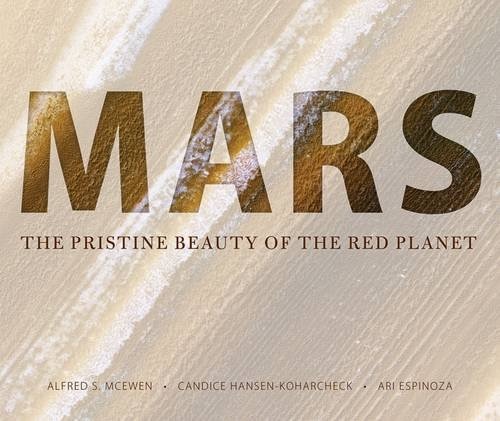Review: Mars: The Pristine Beauty of the Red Planetby Jeff Foust
|
| MRO’s main camera has opened a new window into the study of Mars, revealing landscapes at times eerily familiar to the Earth, and at other times simply eerie. |
A case, though, can be made for a mission that has typically flown under the radar—or, rather, far above it. The Mars Reconnaissance Orbiter (MRO) has been in orbit around the planet since March of 2006, taking tens of thousands of images of the planet. With a resolution of as sharp as a quarter-meter per pixel, rivaling the best unclassified images of the Earth, MRO’s main camera has opened a new window into the study of Mars, revealing landscapes at times eerily familiar to the Earth, and at other times simply eerie.
Those images, available throughout the mission on the web site for the High Resolution Imaging Science Experiment, or HiRISE, camera, are now also available in a beautiful book, Mars: The Pristine Beauty of the Red Planet. It offers a sampling of the various landforms seen on Mars, from the relatively new to the ancient, in sharp detail and in color.
The book starts with some of those new features, such as dunes drifting across the surface, landslides, the seasonal variations of the polar caps, and even craters formed by impacts since the spacecraft’s arrival. A second section looks at older terrains, from ancient volcanoes to channels and lakebeds created when the planet was warmer and wetter. A final section offers a grab bag of other images, such as unusual landforms that still defy explanation to images of spacecraft on the surface as seen by MRO from orbit.
| It may be a little hyperbolic to call this the “most original science book” ever, but it is a stunning one. |
Each picture comes with a brief explanation or no more than a paragraph, describing the image and its significance. These explanations are repeated in a rotating series of languages, from Arabic to Welsh, alongside the English versions, a feature that seems more poetic than practical. In the book’s preface, co-author Ari Espinoza, the media contact and outreach lead for HiRISE, said that was in line with the desire to have HiRISE be the “people’s camera.” “If anything, this is the most original science book ever made, bringing voices from across our world together to describe another one, in languages that many people know and in others that have never before been used in a single volume,” Espinoza writes.
It may be a little hyperbolic to call Mars: The Pristine Beauty of the Red Planet the “most original science book” ever, but it is a stunning one. It’s a large book, weighing in at nearly four kilograms, and also an expensive one. But for those fascinated by Mars, it’s worth it. The book reveals how complex—and, yes, how beautiful—Mars has turned out to be.
As for MRO itself, it continues to operate in Mars orbit, hopefully for many years to come, as NASA weighs sending another orbiter with a high-resolution camera some time in the 2020s. In the introduction, McEwen and Hansen-Koharcheck, the principal and deputy principal investigators, respectively, of HiRISE, note that MRO has enough fuel to continue operations for 20 years, but that it’s likely something else will break down on the spacecraft before then. “We cannot predict the future, but we hope HiRISE will complete a second decade,” they write. Perhaps long enough for a second volume of images from an alluring, alien world.
